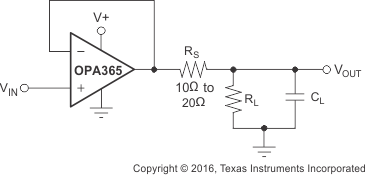SBOS365G may 2006 – may 2023 OPA2365 , OPA365
PRODUCTION DATA
- 1
- 1 Features
- 2 Applications
- 3 Description
- 4 Revision History
- 5 Device Comparison Table
- 6 Pin Configuration and Functions
- 7 Specifications
- 8 Detailed Description
- 9 Application and Implementation
- 10Device and Documentation Support
- 11Mechanical, Packaging, and Orderable Information
Package Options
Mechanical Data (Package|Pins)
- D|8
Thermal pad, mechanical data (Package|Pins)
Orderable Information
8.3.3 Capacitive Loads
The OPAx365 can be used in applications where driving a capacitive load is required. As with all op amps, there can be specific instances where the OPAx365 become unstable, leading to oscillation. The particular op-amp circuit configuration, layout, gain, and output loading are some of the factors to consider when establishing whether an amplifier will be stable in operation. An op amp in the unity-gain (+1 – V/V) buffer configuration and driving a capacitive load exhibits a greater tendency to be unstable than an amplifier operated at a higher noise gain. The capacitive load, in conjunction with the op amp output resistance, creates a pole within the feedback loop that degrades the phase margin. The degradation of the phase margin increases as the capacitive loading increases.
When operating in the unity-gain configuration, the OPAx365 remain stable with a pure capacitive load up to approximately 1 nF. The equivalent series resistance (ESR) of some very large capacitors (CL > 1 μF) is sufficient to alter the phase characteristics in the feedback loop such that the amplifier remains stable. Increasing the amplifier closed-loop gain allows the amplifier to drive increasingly larger capacitance. This increased capability is evident when observing the overshoot response of the amplifier at higher voltage gains; see also Figure 7-15.
Figure 8-3 shows one technique to increase the capacitive load drive capability of the amplifier operating in unity gain is to insert a small resistor, typically 10 Ω to 20 Ω, in series with the output. This resistor significantly reduces the overshoot and ringing associated with large capacitive loads. A possible problem with this technique is that a voltage divider is created with the added series resistor and any resistor connected in parallel with the capacitive load. The voltage divider introduces a gain error at the output that reduces the output swing. The error contributed by the voltage divider is sometimes insignificant. For instance, with a load resistance, RL = 10 kΩ, and RS = 20 Ω, the gain error is only about 0.2%. However, when RL is decreased to 600 Ω, which the OPAx365 are able to drive, the error increases to 7.5%.
 Figure 8-3 Improving
Capacitive Load Drive
Figure 8-3 Improving
Capacitive Load Drive